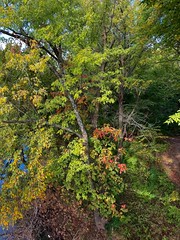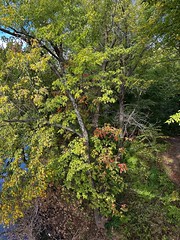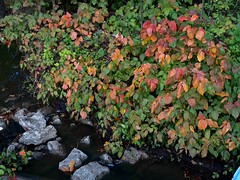I began July 24 driving north from Yachats to Newport for a Sausage McMuffin with Egg at McDonald’s. Thus fast food fortified, I drove east up and over the high northern Cascades through the Santiam Pass. Naturally I got stuck in a line of cars behind a double-trailer fuel truck crawling over the pass, but near the peak I was able to pass on the pass (follow me?) and barrel down into the dry lands east of the range. Annual rainfall plummets from 77 inches in the impressive forest at the Santiam Pass to only 14 inches in Sisters – you quickly realize you’re descending into a desert.
This region had 90,000 acres (roughly 140 square miles) burned up in the B&B Complex Fire back in 2003. The damage was apparent although it certainly made it easier to see Mount Washington.
The road leading through the Deschutes Forest (or partially burned-out wasteland, if you prefer) was only two lanes and cars piled up quickly behind me as I descended at the speed limit. No doubt they celebrated when we entered the town of Sisters, where I turned off for some tasty pizza at Papandrea’s. The lady at the counter was quite friendly and later began cackling like a deranged witch back in the kitchen. I had suspected two boys working in the place were her sons, and that was confirmed when one of them, taking a break in the eating area, started yelling, “Mom, what are you doing?!?” as her cackles continued to cascade. My fellow diners and I had to chuckle, although we never found out what potion she was cooking up back there in her pepperoni pot.
Sisters is an odd name for a town, but easily explained because just north are The Three Sisters, three volcanic peaks which are the 3rd, 4th, and 5th highest in Oregon. Early settlers had named them Faith, Hope, and Charity, but that didn’t catch on. Myself, I haven’t found Oregonians lacking in those three qualities. East of town was a pullout where I snapped a panorama of The Three Sisters and Mount Washington to boot.
I then drove through Bend along Highway 97 to the Newberry National Volcanic Monument. I had done very little research about this part of the trip, so I was surprised at how well it went.
First I turned off at the Lava Lands, paying my day use fee, and was directed to drive up to the top of a 500 foot tall cinder cone. Lava Butte was formed in an eruption 6,160 years ago and covered nine square miles with lava. A trail circumnavigated the crater rim with great views of the crater. Newberry Volcano itself is the largest shield volcano in the state, atypically spewing not only basaltic but also andesitic and rhyolitic lava. At 20 miles in diameter, the cinder cone I drove up is only one of many on Newberry’s flanks.
The summit was infested with chipmunks (later I learned these were golden-mantled ground squirrels, which are slightly larger than chipmunks and lack the strip to the top of the head), with plenty of signs urging patrons to please not feed them. The little rodents were good little beggars, but I was just as unyielding to them as to the beggar who tried to accost me at a McDonald’s earlier in the day at a pit stop. Speaking of pits, I’ve spent so much time hiking that I suspect a third of the toilets I’ve used on this trip have been pit toilets. And that’s the pits.
Surprised that the nearby visitor center wasn’t smart enough to sell ice cream or even drinks (it was 59 degrees Fahrenheit on the coast this morning, but 86+ at Newberry), I disgustedly drove on to what would prove to be the strangest hike of my trip.
The Lava River Cave is the longest known lava tube in Oregon, and you can hike over one mile down it, deep underground. And there is no lighting along the tube – you either bring your own flashlight or rent a lantern. So I had a great time strolling through the tube today with a Coleman lantern.
The entrance looks much like any other cave, and the interior does vary in diameter but the trend is clear. This thing has no forks and gets smaller and smaller toward the “end”. There are no loops on this trail: you stroll down the tube, which has a somewhat uneven but quite walkable floor, until it narrows to a crawlspace. Then you turn around and go to the light, which is over a mile back. I didn’t make it as far as a couple of small children who had gone ahead a few dozen feet after my stopping point. I could see their light burning away down there, and I left them to their fate. Oh, their mother was with them – I heard her screams.
Just kidding, although noticing some of the fissures in the tube and knowing this area had earthquakes did make the long dark tube a bit spookier. But it was a fun and unique experience, and inside the tube it was so cold you can see my breath in several of the photos. A 44-degree temperature drop on a hot summer day out in fields of lava is most welcome, especially when the Lava Lands Visitor Center does not provide ice cream nor drinks. I’m talking to you, Forest Service!
The lava tube tacked another 2.2 miles to my trekking total for the trip. I added another mile to the count farther south at the Lava Cast Forest. Here an eruption spilled lava through a pine forest, flowing against the upstream side of the trunks and forming a mold as the tree burned within. Today the area is covered not only in rough lava and ash, but is peppered with odd vertical cylindrical hollows that are the tree molds. I shot some video footage down a couple of them.
Oddities along the trail included horizontal tree molds and nature’s attempts to undue the damage of 6,000 years ago with butterflies, trees, dead trees, weird dead trees, and even a flowering plant or two.
I then drove on to the Newberry Caldera, which has two lakes in it and a large obsidian flow. Tiny Lake Paulina was charming and seemed far more hospitable than the immense Crater Lake I visited in 2006. But I was more fascinated by the huge black glassy chunks of obsidian at the immense flow formed by rhyolitic lava. A mile-long trail winds up and around the flow, and I posed not once, but twice, and was still not satisfied until I shot a couple of kids posing.
But perhaps the best thing about the Newberry Caldera was, yes, they sold ice cream and drinks there at a little store at Lake Paulina. All is forgiven, Forest Service.
It was a long drive today, something I finally noticed when I was driving out onto the Newberry Caldera with the nearest gas station 15 miles away and the car gas gauge steadily sinking towards E. Not wanting to take a chance at being mocked for running out of gas on the caldera of a dormant volcano, I turned off the air conditioning to conserve fuel and as I left the area noticed the Saturn displaying “LOW FUEL” on its computerized readout. Okay, I get it! I told Trixie the GPS to find the nearest station pronto. When the gas attendant asked me whether I flew the car from Hawaii or brought it over on a boat, I resisted saying, “Yes, I flew it, just like in Chitty Chitty Bang Bang.”
Yelp steered me up through Bend to the La Rosa restaurant for absolutely delicious fajitas. Dare I say they were even better than my old favorite, El Chico? Yes, I’m afraid they were. Bend is an interesting city. It was only 52,000 back in 2000 but has reached 82,000 today with 216,000 in the metro area. This immense growth has created an odd place where the cute downtown has many small pricey-looking upscale buildings and there are some more typical neighborhoods surrounding it, but the outer areas are models of new urbanism.
There are roundabouts everywhere, which studies show are good traffic calmers. They’ve even stuck them into older neighborhoods when they could. And I didn’t see hardly any of the big mile-grid streets like we have back home. Instead you have to wind your way around on narrow streets everywhere, but traffic even on a Friday night in the busy areas was pretty light and easy to manage.
Highway 97 running north-south through Bend is a model of new thinking. They didn’t let it clog up like highway 75 in Bartlesville. It is mostly restricted access with ramps or stop lights only at mile intervals, gliding you along at 45 miles per hour. They avoided ugly frontage roads but instead have a very broad “green strip” along the sides, although in this climate there is little green besides pine needles. The green strip is broad enough that you can’t see the neighborhoods or businesses off the highway, and in other areas they use high walls to block it all off. So you can drive clear through Bend and only see brief glimpses of the city around you, instead enjoying distant vistas of volcanic mountains and short green forests.
There are oodles of sidewalks and other pedestrian-friendly features around the town. This sort of modern development is most appealing and is in stark contrast to the absolutely horrid urban planning (or sprawling urban madness) ones sees in Tulsa and Oklahoma City. Just think if Owasso or Moore had taken this route instead of becoming horrid soulless abominations.
Well, as I post this and today’s slideshow, it is past midnight. So I am LONG overdue for that hot tub that awaits me here at the Quality Inn. I can’t neglect it, since after today it is just Motel 6 for the weekend. I don’t have much of a plan yet for tomorrow other than to drive north so that I arrive at The Dalles by nightfall.
Happy trails…or should I say lava tubes?
[Next post: Deserts and Rivers: Day 9 of the Oregon Trails]







Pingback: Cape Perpetua and Smelt Sands: Day 7 of the Oregon Trails « MEADOR.ORG ~ The virtual world of Granger Meador
I enjoyed your description. Is there anyway you could tell me how to best approach this area. I’m driving an rv from nw Utah to Washington and don’t know if I should go across 26 or drop down 97, then retrace my steps or continue to Eugene and then up 5. Any ideas.?
I’m no expert on the highways east of Bend, having only gone as far east from the Oregon coast as US 97, but I presume you could follow this route, using US 26 instead of US 20 so that you see more forest and it sounds like US 26 is a better highway for larger vehicles:
http://goo.gl/maps/ICJr
http://en.wikipedia.org/wiki/U.S._Route_20_in_Oregon
http://en.wikipedia.org/wiki/U.S._Route_26_in_Oregon
Here’s a link to the Newberry Volcanic Monument site – you’ll want to visit the Lava Lands Visitor Center first to get a good map of the various features scattered across the large area:
http://www.fs.usda.gov/wps/portal/fsinternet/!ut/p/c5/04_SB8K8xLLM9MSSzPy8xBz9CP0os3gDfxMDT8MwRydLA1cj72BTn0AjAwgAykeaxcN4jhYG_h4eYX5hPgYwefy6w0H24dcPNgEHcDTQ9_PIz03VL8iNMMgycVQEADoWIdk!/dl3/d3/L2dJQSEvUUt3QS9ZQnZ3LzZfME80MEkxVkFCOTBFMktTNUJIMjAwMDAwMDA!/?ss=110601&navtype=BROWSEBYSUBJECT&navid=110000000000000&pnavid=null&recid=66159&ttype=recarea&pname=Newberry%20National%20Volcanic%20Monument%20-%20Deschutes%20NF%20-%20Home